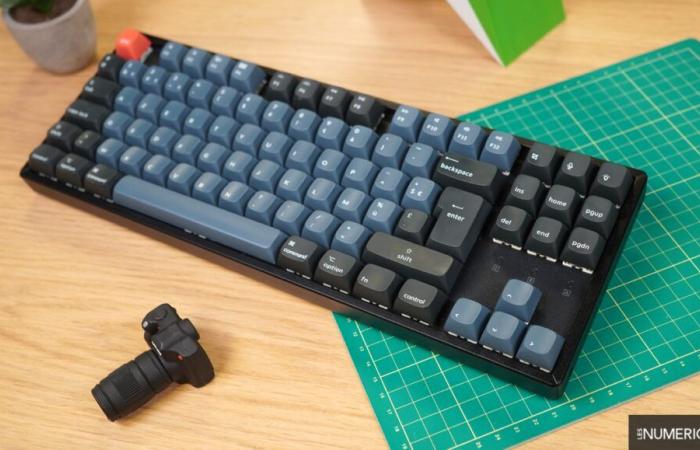In the very special world of lovers of PBT keys and switches that go tac-tac-tac, Keychron keyboards are among the most celebrated references. The Hong Kong manufacturer has built a reputation on the mid-range market, offering quality/price ratios which, on paper, are attractive.
So we couldn't wait to put them to the test, starting here with the K8 Pro, a TKL model (tenkeylesswithout numeric keypad) sold for a little over €100 in stores. An attractive price placement, behind other similar, more expensive options like the Logitech G Pro X TKL Lightspeed or the Designed by GG Berserker.
Behind this somewhat barbaric name hides a nomenclature which needs to be tamed. Thus, the letter K designates the “standard” range of Keychron, guaranteeing an aluminum chassis and macOS and Windows compatibility. The number indicates its profile: low-profile for odd numbers, “normal” profile for even numbers. Finally, the Pro refers to the switches, the famous Gateron G Pro. Available in red (linear) or brown (tactile), it is the latter which are used in our test exercise.
Ergonomics
As explained above, the frame of the Keychron K8 Pro is made of aluminum, which gives it a certain weight: 1.14 kg to be precise, a pretty baby. The impression of solidity is obvious and allows it to avoid bending slightly under the pressure of pressing the keys. There are no problems to report on the profile of the keyboard, which can be raised with two wedges at two different levels depending on preferences. Please note that no wrist rest is included in the offer. Given its height, it is recommended to add one to the K8 Pro to avoid fatigue.
View above the Keychron K8 Pro.
© Les Numériques
Downside regarding its construction, in its French ISO layout, that used for all keyboards in the French-speaking standard, the keycaps are only available in ABS (acrylonitrile butadiene styrene), a material widely used in the keyboard industry, but not without problems. Susceptible to the natural oils of our fingers, the keys keep marks, which can cause their screen printing to crumble in the long term. You will need to wipe it regularly to avoid this kind of hassle. To benefit from the PBT (polybutylene terephthalate) keys, which are more durable over time, you will need to choose another keyboard layout.
The choice of ABS for the keys has its disadvantages.
© Les Numériques
There is nevertheless an advantage to opting for ABS according to the official Keychron technical sheet. This material allows the backlight to pass through the translucent screen printing, which is not the case with keycaps in PBS marketed by Keychron. The screen prints would thus be more readable in a dark environment, once the backlighting is set to good brightness. A strange observation, PBT does not block the passage of light among other manufacturers…
The transition is perfect to evoke RGB backlighting. Oriented south, the LEDs are clearly visible without “overflowing” onto parts of the keycaps — a problem which is nevertheless measured over a longer period of time. With 22 display configurations (fixed, cascade, gradient, etc.), there is plenty of fun for tuning enthusiasts, especially since the maximum backlight brightness is particularly high.
The Keychron K8 Pro comes with a USB-C cable, a dozen keys, a switch and keycap pulleras well as a small screwdriver.
© Les Numériques
Keychron being a brand essentially designed for macOS users, the keyboard layout is by default aligned with other Apple brand keyboards, with the Option keys and the rearrangement of certain characters, notably on the row of number keys. Windows accounting is however fully ensured using a side switch which allows you to switch to the second mode of bidding of keys. In addition, a dozen keycaps are included to adapt to the ISO FR format by repositioning the “!” keys, Windows, and so on.
The switches on the left side of the Keychron K8 Pro.
© Les Numériques
In terms of connectivity, the Keychron K8 Pro can be used wired via a braided USB-C to USB-A cable (included) or via Bluetooth 5.1. The latter can be linked to three different devices and switched at any time using a dedicated shortcut. For intensive users, we logically recommend sticking to a wired connection to avoid any interference with Bluetooth. It is a shame that 2.4 GHz connectivity, preferable for gaming in wirelessis not proposed. Keychron promises up to 300 hours of battery life without backlighting, a third in minimum brightness. We haven't had to recharge the Keychron (without RBG) since the start of our test.

Struck
The famous brown Gateron Pro G switch.
© Les Numériques
After a first divisive version of its tactile switches, Gateron revised its copy with the Gateron G Pro. And the result is more than successful. At first, the feeling can be confusing. It is far from being noisy or offering as frank a feedback as, for example, the Cherry or the Brown Raccoon from the Berserker by Design by GG. However, we quickly get used to this lighter strike, which nonetheless retains its impact, thanks to the pre-lubrication of its switches.
The larger keys, such as the space bar and Enter, have an even more attenuated press. Overall, the sound is hushed, almost muffled and warm, for a feeling that is ultimately quite unique on the market. This is the product of a very short actuation travel (1.2 mm) and a measured actuation force (55 cN compared to 45 cN for Gateron Pro red switches). A little extra for its longevity, the K8 Pro is hot-swappablethat is, its switches are not soldered to the circuit board and can be replaced in case of failure with any other three to five pin MX switch.







